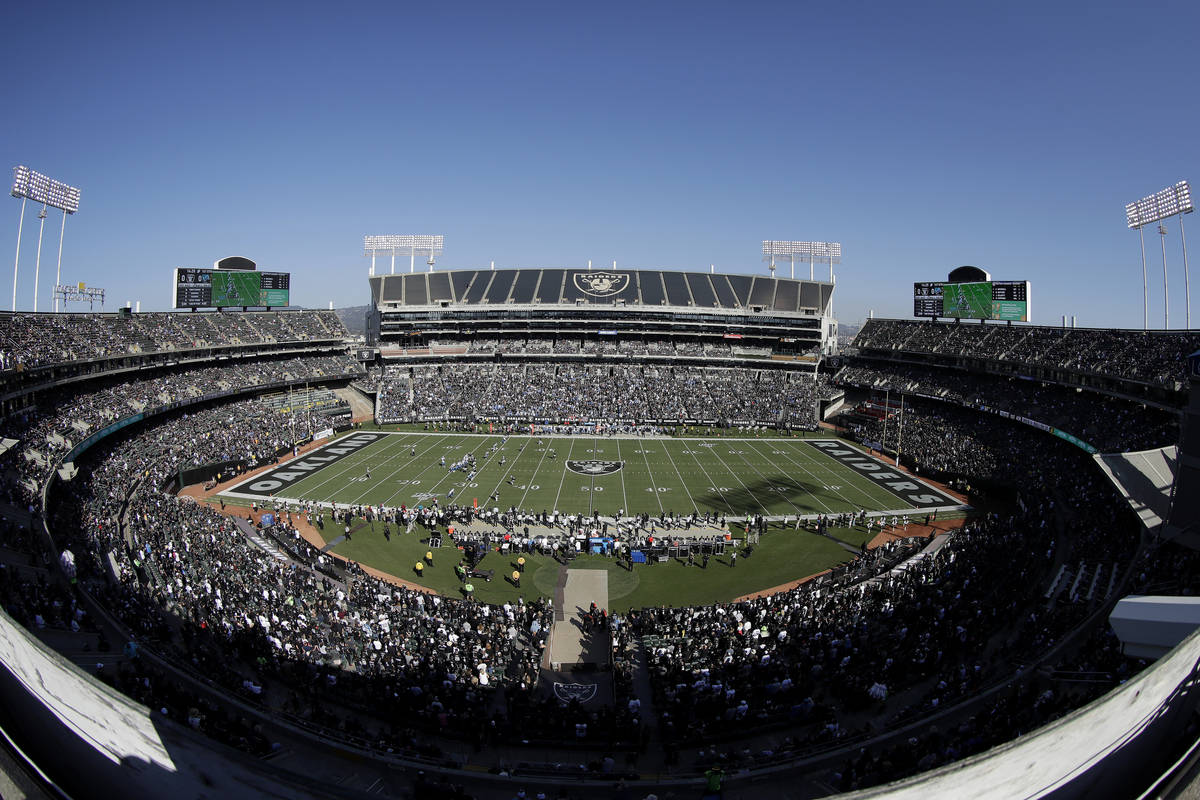5 things about Raiders’ former home stadiums

Editor’s note: This is part of an occasional series acquainting fans with the Raiders’ illustrious 60-year history as the team moves to Las Vegas for the 2020 season.
The roof at Allegiant Stadium was completed this week as the Raiders’ new home on the Las Vegas Strip took a symbolic step toward completion.
The 65,000-seat, $1.84 billion facility will be the first domed stadium the team has called home. It will be the sixth stadium in which the Raiders have played.
Here’s a fun (or in some cases sobering) fact about each of the other five:
— Kezar Stadium (1960): The Raiders played their first four home games of the inaugural season at the multipurpose stadium located in San Francisco’s Golden Gate Park. Scenes from the iconic movie “Dirty Harry” were shot in Kezar. The movie’s villain was portrayed as a stadium caretaker who lived under the stands.
Bloody superb filmmaking: At Kezar Stadium, Dirty Harry descends upon Scorpio, the psychopath who maimed and bitched him.
That fog is not an effect, it’s genuine. #HappyAccident ☁️ pic.twitter.com/W4XP13JZMI— Dame Taft (@SelectWomanTaft) September 7, 2019
— Candlestick Park (1960-61): The Raiders temporarily moved into Candlestick Park, home of baseball’s San Francisco Giants, during their formative years. Candlestick was a focal point of the 1989 Loma Prieta earthquake before Game 3 of the World Series and was the site of the Beatles’ final full public concert in 1966.
Policemen clear the field of enthusiastic fans as The Beatles perform on a bandstand in Candlestick Park, San Francisco, California, Aug 30, 1966. pic.twitter.com/n4VKRj0m6r
— History Lovers Club (@historylvrsclub) November 8, 2019
— Frank Youell Field (1962-65): The Raiders called quaint Youell Field on the Laney College campus home for several seasons while the Oakland Coliseum was under construction. Youell Field, which seated 22,000, was named for a local undertaker and sports fan.
— Oakland Coliseum (1966-81; 1995-2019): The monolithic gray edifice that has been called one of the worst stadiums in pro sports was considered state of the art when the Raiders became its first pro tenant. In addition to twice serving as the team’s home and site of many of its greatest triumphs, the Coliseum has hosted two perfect games (by Catfish Hunter and Dallas Braden of the Oakland Athletics), concerts featuring the Rolling Stones, Marvin Gaye, Led Zeppelin, U2 and Parliament-Funkadelic, and several raw sewage backups.
On this date in 2010, which was Mother’s Day, Dallas Braden pitched the 19th perfect game in MLB history against Tampa Bay. It was the second by an Athletic and came 42 years and one day after Catfish Hunter did it against Minnesota on May 8, 1968. pic.twitter.com/NExjq6mVG6
— Oakland A's (@Athletics) May 9, 2018
— Los Angeles Memorial Coliseum (1982-94): The Raiders won a Super Bowl, four American Football Conference championships and compiled an 84-36 home record after moving into Los Angeles’ more venerable coliseum. It has hosted three Olympic Games, the 1959 World Series, the first Super Bowl, a Billy Graham crusade, a 1947 Notre Dame-USC college football game that attracted a crowd of 104,953 and TV episodes featuring Columbo and the Incredible Hulk.
Los Angeles Memorial Coliseum – home of the #Dodgers for a short while pic.twitter.com/3G87tdELKf
— BaseballHistoryNut (@nut_history) April 14, 2020
— Honorable mention: Memorial Stadium, Berkeley, California (1973): Because of a scheduling conflict with the A’s, the Raiders played the Miami Dolphins on the University of California campus on Sept. 23, 1973. George Blanda kicked four field goals in the Raiders’ 12-7 win that snapped Miami’s 19-game winning streak. The game was played in front of 74,121 — the largest crowd to watch a Raiders game during their Oakland years.
Did you know the Raiders played a regular season game at Berkeley’s California Memorial Stadium? pic.twitter.com/dbsE5ym8kG
— S-T-A-Y. H-O-M-E (@HellaADZ_) August 29, 2018
Contact Ron Kantowski at rkantowski@reviewjournal.com or 702-383-0352. Follow @ronkantowski on Twitter.